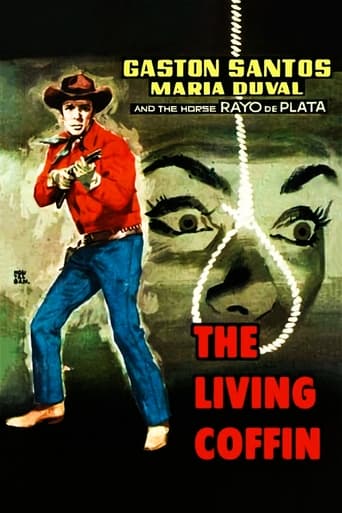ChicDragon
It's a mild crowd pleaser for people who are exhausted by blockbusters.
FrogGlace
In other words,this film is a surreal ride.
Mehdi Hoffman
There's a more than satisfactory amount of boom-boom in the movie's trim running time.
Guillelmina
The film's masterful storytelling did its job. The message was clear. No need to overdo.
Michael Ledo
A man on a white horse rides into town looking for the woman that carved a statue. She is dead. The doctor has one too. Dead woman is said to be haunting the swamp, yet at the same time she is kept dead by jamming a knife into a perfectly good clock.Yes, we do get to see the dead woman. Boring film.
Edgar Soberon Torchia
Not much to recommend here: this motion picture has a few elements reminiscent of "El vampiro" (the ghostly woman walking through dark corridors, the evil surrounding the sets of the dark hacienda in contrast to the sunny exteriors, humor combined with terror) but director Fernando Méndez and screenwriter Ramón Obón were not up to that previous collaboration. Obón would still write a few fine horror scripts (as "El mundo de los vampiros" and "La loba"), but Méndez stopped directing movies two years later, after making a routine western diptych and a formulaic melodrama. The leading man (swinger Gastón Santos, rich son of the big señor of his hometown, in real life) is prettier than the whole cast, but everybody acts better than him. He plays some kind of lone ranger and detective who arrives at a gloomy hacienda where an old woman (Hortensia Santoveña) lives in fright of her dead sister's spell, objecting all intents by her young niece (María Duval) to make life happier in the country side. The few persons remaining in a once prosperous town now live in fright of the vengeful Llorona (Crying Woman), who is somehow connected to the town doctor, two statues sculptured on a strange stone, a deadly swamp and killer cowboys. Santos is a good rider though and his horse Rayo de Plata also plays a key role in the plot, while Pedro de Aguillón plays Santos' sidekick in the lines of a Sancho Panza, adding lines and slapstick here and there, intended to be funny. Unfortunately the action lacks the right spirit, be it comedy or horror, in spite of Gustavo César Carrión's funny effort to add galloping beats to his score. Nothing said if you care for stiff terror westerns with intelligent horses and haunted swamps. Then this is for you.
Michael_Elliott
Living Coffin, The (1959) ** (out of 4) Mexican film that mixes the Western and Horror genres while at the same time connects the main villain to The Crying Woman character of various other Mexican films. Two cowboys show up to help some ranchers rid their curse, which appears to be the work of the ghost The Crying Woman. I was shocked to see how fast this 71-minute film flew by. A lot of these Mexican movies move rather slowly but that wasn't the case here. The look of The Crying Woman is very cheap but effective and the performances aren't as bad as you'd think and in fact they manage to be pretty good. The horror elements work very nicely but the Western stuff never really takes off too well. The ending is also a major disappointment and comes over very badly but overall this isn't too bad of a film but I'd recommend starting with a different Mexican film. Original title: Grito de la muerte, El.
Coventry
Horror and Westerns generally don't form a great cinematic match, but Fernando Mendez' "The Living Coffin" has a fairly good story and contains a handful of admirable ideas. The plot combines typical western bar fights and heroic cowboy characters with favorite Gothic horror subjects like the legend of the crying woman (processed much better in another contemporary Mexican feature entitled "The Curse of the Crying Woman), premature burial and local superstition. In a small town near a sinister swamp, the restless spirit of the "crying woman" supposedly haunts the remote mansion of an eminent family. She passed away nearly a year ago, but her cries in agony over the loss of her two children can often be heard in the swamp, and her remaining relatives (a sister and an attractive young niece) fear supernatural acts of vengeance. A knife in a clock protects the house, but when it gets removed the ghost emerges from the coffin. Luckily enough, the courageous cowboy Gaston and his unusually intelligent horse travel through the area, and they'll figure out whether there really are ghosts or just a fiendish conspiracy to steal the family's fortune. The sequences in the swamp as well as inside the mansion's catacombs are surprisingly atmospheric and there's a fair share of morbid scenery, like the tomb and crying lady's make-up. Unfortunately, however, there are approximately as many negative elements as there are positive ones, including the cowboy's totally redundant sidekick, whose job is provide an unnecessary comic relief as he always falls asleep and frequently gets hit on the head, and the utterly implausible capacities of Gaston's horse. The animal is actually the real hero here, because he saves his owner's life on several occasions, randomly discovers secret passageways and even defeats the enemies in a totally laughable finale. "The Living Coffin" is a worthwhile effort, but nowhere near as breathtaking and unforgettable as the aforementioned "Curse of the Crying Woman" and Fernando Mendez' other directorial masterpiece "The Black Pit of Dr. M".

